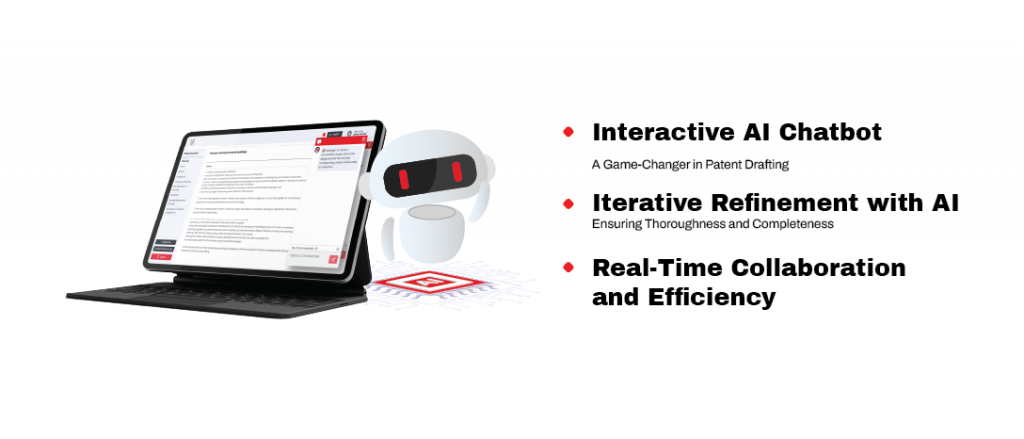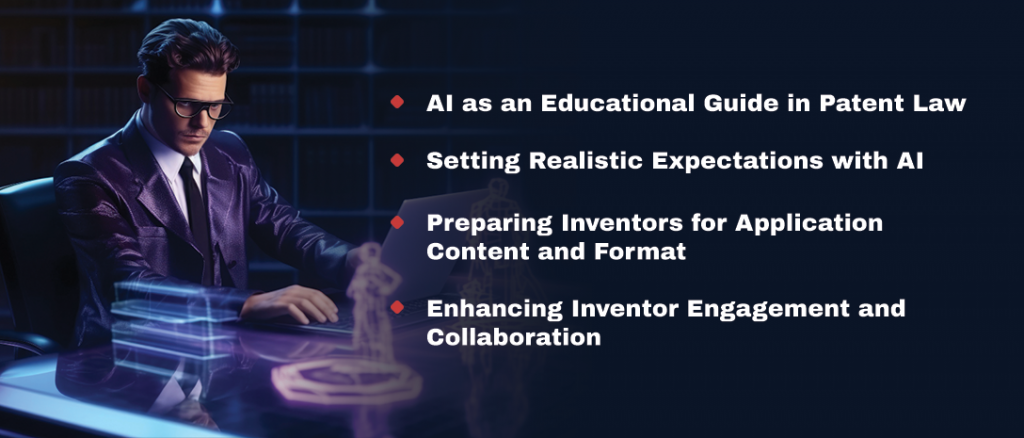
Introduction
Artificial Intelligence (AI) is revolutionizing various professional domains, and the field of patent drafting is no exception. In this era where innovation is booming at breakneck speeds, the legal frameworks designed to protect these advancements must evolve correspondingly.
This is where AI, particularly with platforms like Drafting LLM, is making a significant impact.
In this blog we will discuss how AI is reshaping the process of patent drafting, making it more efficient, comprehensive, and future-proof.
Patent drafting is a complex process, traditionally requiring hours of laborious effort from skilled attorneys to ensure that every aspect of an invention is accurately and legally protected.
Utilizing large language models (LLMs) and advanced generative AI, Drafting LLM can produce AI-generated preliminary patent drafts within minutes.
The real strength of Drafting LLM is that it combines the power of AI with the nuanced understanding of human experts. AI, in this context, does not replace patent attorneys but rather augments their capabilities.
Another transformative aspect of AI in patent drafting is its predictive ability. By analyzing vast amounts of data, AI can identify patterns and trends that humans might miss.
This predictive power can anticipate future technological developments, ensuring that a patent remains relevant and robust in the face of rapid innovation. It also aids in identifying potential alternative implementations of the invention, thereby safeguarding against future design-around efforts.
As we delve deeper into this blog, we will uncover more about how AI is revolutionizing the patent drafting process. Stay tuned as we explore these facets in greater detail, shedding light on how AI is not only changing the way patents are drafted but also how it is shaping the future of legal practice in the technological domain.
The Advent of AI in Patent Drafting: An Overview of Drafting LLM
Drafting LLM is at the forefront of a new era in patent law, representing a synthesis of advanced AI technologies and legal expertise. At its core, the platform employs LLMs, which are sophisticated AI algorithms trained on vast datasets of legal documents, patent applications, and technical texts.
These models can understand and generate human-like text, making them particularly suited for tasks like drafting patent applications.
Complementing these LLMs, Drafting LLM also utilizes generative AI, a technology adept at creating content – in this case, legal documents – that is coherent, contextually relevant, and tailored to specific requirements.
The process begins when an inventor or attorney inputs the details of an invention into the Drafting LLM platform. The AI then analyzes this information, using its training and algorithms to identify key elements that need to be included in a patent application.
Leveraging its database of legal knowledge and patent-specific information, Drafting LLM generates a preliminary draft of the patent application, addressing all critical aspects from claims to detailed descriptions.
One of the most striking benefits of Drafting LLM is the speed at which it can produce these preliminary drafts. Traditionally, drafting a patent application is a time-consuming process, often taking days or even weeks to produce a first draft.
Drafting LLM, however, can reduce this to a matter of minutes. This rapid turnaround is not just a matter of convenience; it represents a significant strategic advantage in the drafting process, where the timeliness of an application can be as crucial as its content.
The speed of Drafting LLM does not compromise the quality or comprehensiveness of the draft. The AI model ensures that all necessary legal standards are met and that the draft encompasses all aspects of the invention, including potential future applications and iterations.
Moreover, the efficiency of Drafting LLM allows attorneys and inventors to focus on refining and customizing the draft. Instead of spending hours on initial drafting, legal professionals can direct their efforts towards enhancing the application, ensuring it aligns perfectly with the inventor’s vision and the nuances of the invention.
This shift in focus from creation to refinement elevates the quality of the final patent application, making it more robust and tailored to the specific needs of the invention.
Another significant advantage of Drafting LLM’s rapid drafting capability is its impact on the patent application process. In a domain where time-to-market is of utmost importance, being able to quickly secure patent protection can be a game-changer for inventors and companies alike.
It accelerates the process of bringing new innovations to the market, providing a competitive edge in fast-paced industries.
Enhancing the Inventor Interview with AI Insights
In the patent drafting process, the initial inventor interview is a pivotal moment. The incorporation of Artificial Intelligence (AI), particularly through platforms like Drafting LLM, has introduced a groundbreaking dimension to this process.
AI’s ability to assist in the inventor interview by offering insights and relevant questions is a transformative shift that lays a robust foundation for a compelling patent application.
The traditional inventor interview involves a patent attorney diving into the technicalities and nuances of an invention, trying to obtain every relevant detail. It’s a process that relies heavily on the attorney’s expertise and the inventor’s ability to articulate their creation. However, this dynamic changes significantly with the introduction of AI. The inclusion of AI in the patent drafting process brings a new level of depth and precision to these interviews.
At the outset, LLMs can analyze preliminary information about the invention provided by the inventor. This initial analysis allows it to formulate targeted, insightful questions that might not be immediately apparent.
Moreover, AI can assist in identifying potential future applications or improvements of the invention. By analyzing existing patents and current technological trends, the AI can guide the attorney to explore areas that the inventor might not have considered.
This foresight is invaluable in creating a patent application that is not only relevant at the time of filing but remains robust and protective as the technology evolves.
Automated patent drafting also harnesses the power to customize the line of questioning based on the specific field of the invention. Different technological fields have different critical factors and legal precedents that need to be considered.
The AI’s understanding of these nuances allows it to tailor the interview process to be as effective and relevant as possible for each unique invention.
The data-driven insights provided by AI also help in setting realistic expectations for the inventor. By presenting a clear overview of similar patents and the current state of the art, the AI can help the inventor understand the likely scope and limitations of their patent protection.
This understanding is vital in shaping a patent application that aligns with the inventor’s expectations and the legal realities of patent law.
Furthermore, AI’s role in the inventor interview extends beyond just gathering information. It can also assist in drafting an initial version of the patent application, based on the information collected. This draft serves as a starting point for further refinement by the attorney, accelerating the overall drafting process.
Comprehensive AI-Assisted Review and Refinement

The precision and comprehensiveness of the final document are paramount. This is where Drafting LLM comes into play, revolutionizing the process through its interactive AI chatbot.
This feature assists in real-time refinement and enhancement of patent drafts, ensuring a level of thoroughness and completeness that sets a new standard in patent documentation.
Interactive AI Chatbot: A Game-Changer in Patent Drafting
Drafting LLM’s interactive AI chatbot represents a significant leap forward in patent drafting technology. This tool functions as a dynamic assistant, engaging with patent attorneys and inventors in real-time to refine and enhance patent drafts.
The chatbot can analyze the text of a draft, provide suggestions for improvements, identify areas that may need additional detail or clarification, and even highlight potential legal issues.
The AI chatbot’s ability to process natural language allows it to understand the context and intricacies of the patent draft. As the user interacts with the chatbot, it can respond with relevant legal precedents, suggest alternative phrasings for clarity or broader protection, and ensure that the draft adheres to all necessary patent laws and guidelines.
This level of interaction not only improves the quality of the draft but also serves as an educational tool for attorneys and inventors, deepening their understanding of the nuances of patent law.
Iterative Refinement with AI: Ensuring Thoroughness and Completeness
The process of refining a patent draft is inherently iterative. It requires careful review and multiple revisions to ensure that every aspect of the invention is accurately and comprehensively covered. Drafting LLM’s AI chatbot helps streamline this process.
The user can make changes to the draft by providing it with prompts as per the user’s needs. This iterative process, facilitated by AI, ensures that each version of the draft is an improvement over the last.
Real-Time Collaboration and Efficiency
One of the most significant advantages of Drafting LLM’s AI chatbot is its ability to facilitate real-time collaboration. Users can use the chatbot as a sounding board, testing out different phrasings or concepts. This collaborative approach, enabled by AI, significantly reduces the time and effort typically required for patent drafting.
Educating Inventors: AI’s Role in Setting Expectations

Educating inventors about the complexities of the patent process is crucial. This is particularly true for those new to the field, who may find the maze of legal requirements and procedures overwhelming.
LLMs and Generative AI-based models play a pivotal role in demystifying this process, setting clear expectations, and preparing inventors for the journey ahead.
AI’s capacity to simplify, explain, and predict makes it an invaluable tool in bridging the knowledge gap for inventors, ensuring they are well-informed and comfortable throughout the patent application process.
AI as an Educational Guide in Patent Law
The journey of obtaining a patent can be difficult, with various steps and legal nuances that may not be immediately apparent to inventors. AI, with its vast repository of legal knowledge and data, can act as an educational guide.
Platforms like Drafting LLM can provide inventors with an overview of the patent process, breaking down each stage into understandable segments. This might include explanations of the importance of patent searches, the criteria for patentability, the process of drafting claims, and the nuances of patent prosecution.
AI systems can present this information in a user-friendly manner, perhaps through interactive tutorials or Q&A sessions, where inventors can ask specific questions and receive immediate, tailored responses. This kind of interactive learning is particularly effective in helping inventors understand complex legal concepts and procedures.
Setting Realistic Expectations with AI
One of the challenges inventors face is developing realistic expectations about the patent process and the protection it can offer. AI can analyze similar patents and historical data to provide inventors with a realistic view of what to expect.
For instance, AI can offer insights into the typical time frames for patent approval in different jurisdictions, the likelihood of facing objections, and the scope of protection that similar inventions have received.
This information helps inventors set realistic expectations, reducing the potential for frustration or disappointment. It also aids in making informed decisions, such as whether to pursue a patent application or seek other forms of intellectual property protection.
Preparing Inventors for Application Content and Format
A critical aspect of the patent process is the preparation of the patent application itself. The content and format of a patent application are governed by strict legal requirements, and non-adherence can lead to rejection or weak patent protection.
AI can educate inventors on these requirements, explaining the purpose and structure of each section of a patent application, from the abstract and specification to the claims and drawings.
Enhancing Inventor Engagement and Collaboration
AI also enhances the level of engagement and collaboration between inventors and patent attorneys. Armed with the knowledge imparted by AI, inventors can be more active participants in the drafting process.
They can provide more detailed and relevant information, ask informed questions, and better understand the strategic decisions made by their attorneys.
This informed collaboration leads to a more efficient patent drafting process, with a higher likelihood of producing a strong, enforceable patent. It also ensures that the final patent application accurately reflects the inventor’s vision and the unique aspects of their invention.
Streamlining the Review Process with AI Collaboration
The patent review process, traditionally marked by extensive revisions and rigorous scrutiny, is undergoing a transformative shift thanks to the advent of Artificial Intelligence (AI).
AI collaboration, particularly in platforms like Drafting LLM, is redefining this process, making it more efficient and effective. This synergy between AI and legal expertise streamlines the review process and enhances the overall quality of patent applications, increasing the likelihood of initial approval.
Reducing the Need for Revisions Through AI Collaboration
One of the most significant challenges in patent drafting is the iterative process of revisions. Each revision cycle can be time-consuming and resource-intensive. AI’s intervention in this process is game-changing.
By providing real-time analysis of patent drafts, AI can help identify potential issues that might lead to objections or rejections by patent offices. This includes changing unclear language, refining insufficiently described invention aspects, or enhancing claims that are either too broad or too narrow.
Drafting LLM, for example, utilizes sophisticated algorithms to analyze patent drafts in line with current legal standards and precedents. It can cross-reference existing patents, ensuring that the application is distinct and not infringing on existing intellectual property.
By addressing these issues early in the drafting process, AI substantially reduces the need for multiple rounds of revisions, speeding up the path to final submission.
Enhancing Patent Application Quality
The collaboration between AI and legal experts also significantly enhances the quality of patent applications. AI brings a vast repository of data and an ability to process this information efficiently.
When combined with the nuanced understanding and strategic insight of human legal expertise, this results in patent applications that are legally sound and strategically aligned with the inventor’s objectives.
For instance, AI can assist in drafting claims that are optimally worded to ensure broad protection while avoiding overbreadth that might make them invalid.
In conjunction with a human attorney’s understanding of the inventor’s specific needs and the legal landscape, this results in a well-balanced and robust patent application.
Increasing the Likelihood of Initial Approval
Patent offices, such as the USPTO or EPO, have stringent criteria for patent approval. Applications that are clear, precise, and well-argued are more likely to be approved on the first submission.
AI’s ability to analyze and adhere to these criteria can significantly increase the likelihood of initial approval.
By ensuring that all necessary elements of the invention are adequately described and claims are carefully crafted, AI minimizes the common grounds for rejection. This expedites the approval process and reduces the costs associated with multiple filings and amendments.
Streamlining Communication and Collaboration
AI also streamlines the communication and collaboration between inventors and patent attorneys. Platforms like Drafting LLM can serve as a central hub where both parties can review and discuss the patent application in real-time.
This collaborative environment, enhanced by an AI chatbot, fosters a more efficient and cohesive drafting process. Furthermore, AI can help in managing and organizing the documentation required for patent applications.
This includes keeping track of deadlines, and ensuring that all necessary forms and supplementary materials are prepared and submitted accurately.
Customization and Learning Capabilities of AI
An essential aspect of AI in streamlining the review process is its ability to learn and adapt. Over time, AI systems can tailor their analysis and recommendations to align with specific legal preferences and strategies.
This customization ensures that the AI’s contributions are increasingly relevant and valuable in subsequent patent drafting endeavors.
Balancing Legal Precision and Inventor’s Vision with AI

The art of patent drafting lies in striking a balance between legal precision and the inventor’s vision. This equilibrium is crucial in ensuring that the patent not only secures the necessary legal protection but also fully encapsulates the essence of the invention.
Artificial Intelligence (AI), particularly in platforms like Drafting LLM, plays a pivotal role in achieving this balance. AI’s capability to interpret and articulate complex ideas within the stringent confines of legal frameworks is transforming how patents are drafted, ensuring they are both legally sound and true to the inventor’s original concept.
AI’s Role in Harmonizing Inventor’s Vision with Legal Precision
AI’s primary contribution to patent drafting lies in its ability to process vast amounts of information and identify key elements that need to be highlighted in a patent application. This is particularly important when aligning the inventor’s vision with legal requirements.
Inventors often focus on the broader impact or innovative aspects of their creations, while legal professionals concentrate on the technicalities and legalities. AI bridges this gap by translating the inventor’s vision into language that meets legal standards, ensuring the patent application is both comprehensive and compliant.
For example, an inventor might develop a novel energy-efficient engine. While the inventor focuses on the engine’s efficiency and environmental benefits, the AI can help articulate these features in a way that emphasizes their novelty and utility, key criteria for patentability.
It simultaneously ensures that the application includes all the technical details and specifications required to meet legal standards.
AI in Articulating Core Ideas Within Legal Frameworks
AI’s ability to understand and process natural language enables it to articulate the core ideas of an invention in a manner that resonates with patent examiners.
It can analyze the invention’s description provided by the inventor and suggest modifications or additions to ensure clarity and completeness. This is crucial in avoiding ambiguity, which can lead to challenges in patent enforcement.
For instance, if an inventor designs a new software algorithm, the AI can assist in drafting a description that not only explains how the algorithm works but also how it differs from existing solutions.
This precision is essential in securing a patent, as it must clearly define the boundaries of what is being protected.
Streamlining the Claims Drafting Process
Drafting precise claims requires a deep understanding of both the invention and relevant legal standards. AI can streamline this process by suggesting claim language that accurately reflects the invention while adhering to legal requirements.
By analyzing similar patents and legal precedents, AI can guide the drafting of claims that are broad enough to provide extensive protection yet specific enough to be enforceable.
For example, in the case of a new medical device, the AI can help draft claims that cover various iterations of the device, ensuring broad protection. At the same time, it can ensure that these claims are grounded in the technical specifics of the device, thus meeting legal standards.
Enhancing Collaboration Between Inventors and Attorneys
AI also facilitates better collaboration between inventors and patent attorneys. With AI providing a preliminary draft that aligns the inventor’s vision with legal requirements, the attorney can focus more on consulting with the inventor to fine-tune the application. This collaborative approach results in a more nuanced and effective patent application.
Conclusion
In conclusion, the integration of Artificial Intelligence (AI) in the patent drafting process marks a significant paradigm shift in the legal field. The emergence of platforms like Drafting LLM epitomizes this transformation, heralding a new era where innovation in patent law is not just a concept but a reality.
As we have explored, AI’s role in patent drafting extends from the initial stages of drafting to the final stages of application review, encompassing every critical step in between.
Drafting LLM, leveraging Large Language Models (LLMs) and Generative AI, has redefined the efficiency and efficacy of patent drafting. It stands as a beacon of innovation, offering a blend of speed, precision, and foresight that was previously unattainable.
The impact of AI in patent drafting is manifold. It ensures that the inventors’ visions are not lost in translation but are instead enhanced and clearly articulated within the legal frameworks of patent law.
AI’s predictive capabilities, powered by data analysis and pattern recognition, bring an added layer of foresight, anticipating future technological trends and potential improvements. This foresight is invaluable in creating patents that are not only relevant today but also resilient in the face of future innovation.
Moreover, the interactive AI chatbot feature of Drafting LLM introduces a dynamic and efficient means of refining patent drafts. It embodies the essence of AI collaboration, enabling a seamless blend of AI insights with human legal expertise. This synergy is pivotal in reducing the need for extensive revisions and increasing the likelihood of initial approval.
In essence, the advent of AI in patent drafting is not just a technological advancement; it is a catalyst for a more efficient, precise, and visionary approach to patent law.
Platforms like Drafting LLM are at the forefront of this revolution, offering tools that not only streamline the patent drafting process but also enrich it, ensuring that patents are robust, comprehensive, and reflective of the inventors’ true intentions.
As we continue to embrace and integrate AI into legal practices, it becomes increasingly clear that its role in shaping the future of patent drafting and patent law is both significant and indispensable.

